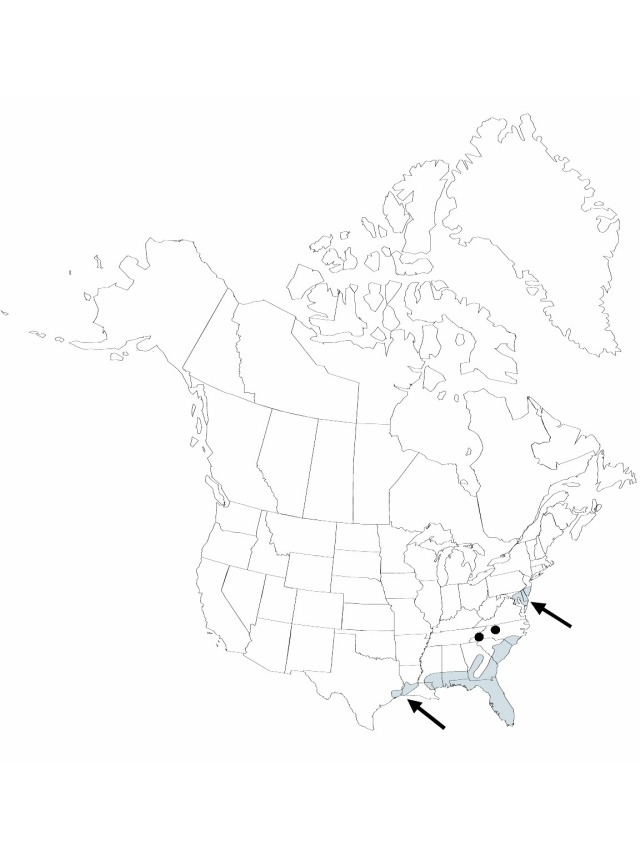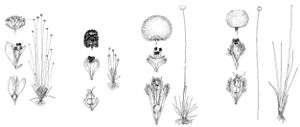Difference between revisions of "Eriocaulon compressum"
in J. Lamarck et al.,Encycl. 3: 276. 1789.
FNA>Volume Importer |
FNA>Volume Importer |
||
| Line 10: | Line 10: | ||
|name=Eriocaulon decangulare | |name=Eriocaulon decangulare | ||
|authority=Walter | |authority=Walter | ||
| + | |rank=species | ||
|publication_title= | |publication_title= | ||
|publication_place=1788, | |publication_place=1788, | ||
| Line 15: | Line 16: | ||
|name=Eriocaulon gnaphalodes | |name=Eriocaulon gnaphalodes | ||
|authority=Michaux | |authority=Michaux | ||
| + | |rank=species | ||
|publication_title=sensu Poiret | |publication_title=sensu Poiret | ||
|publication_place= | |publication_place= | ||
| Line 21: | Line 23: | ||
|name=Eriocaulon cephalotes | |name=Eriocaulon cephalotes | ||
|authority=Michaux | |authority=Michaux | ||
| + | |rank=species | ||
}} {{Treatment/ID/Synonym | }} {{Treatment/ID/Synonym | ||
|name=Sphaerochloa compressa | |name=Sphaerochloa compressa | ||
|authority=Palisot de Beauvois | |authority=Palisot de Beauvois | ||
| + | |rank=species | ||
}} | }} | ||
|hierarchy=Eriocaulaceae;Eriocaulon;Eriocaulon compressum | |hierarchy=Eriocaulaceae;Eriocaulon;Eriocaulon compressum | ||
| Line 48: | Line 52: | ||
-->{{#Taxon: | -->{{#Taxon: | ||
name=Eriocaulon compressum | name=Eriocaulon compressum | ||
| − | |||
|authority=Lamarck in J. Lamarck et al. | |authority=Lamarck in J. Lamarck et al. | ||
|rank=species | |rank=species | ||
| Line 63: | Line 66: | ||
|publication year=1789 | |publication year=1789 | ||
|special status= | |special status= | ||
| − | |source xml=https://jpend@bitbucket.org/aafc-mbb/fna-data-curation.git/src/ | + | |source xml=https://jpend@bitbucket.org/aafc-mbb/fna-data-curation.git/src/f50eec43f223ca0e34566be0b046453a0960e173/coarse_grained_fna_xml/V22/V22_265.xml |
|genus=Eriocaulon | |genus=Eriocaulon | ||
|species=Eriocaulon compressum | |species=Eriocaulon compressum | ||
Revision as of 19:56, 16 December 2019
Herbs, perennial, 20–70 cm. Leaves linear-attenuate, 5–30 cm, apex subulate. Inflorescences: scape sheaths mostly longer than principal leaves, loose; scapes linear, 1–3 mm wide, multiribbed (ribs lacunar); heads chalk white except for dark gray or near black exserted tips of receptacular bracts, anthers, hemispheric to subglobose, 10–20 mm wide, soft, much flattened when pressed; receptacle pilose; involucral bracts frequently squarrose, later obscured by mature bracteoles and flowers, gray, broadly ovate to oblong or elliptic, 2–3 mm, margins entire, apex rounded or obtuse, glabrous; inner bracts, receptacular bracteoles dark gray, spatulate-linear to oblong, 2–3 mm, margins entire, apex acute with white, club-shaped hairs. Staminate flowers: sepals 2, pale or with dark apex, linear or linear-spatulate, 2–4 mm, apex acute to blunt with mealy white, club-shaped hairs; androphore broadly club-shaped; petals 2, pale, oblong, conspicuously unequal, larger lobe apically fringed with pale, club-shaped hairs, smaller lobe glabrous or with a few hairs at apex; stamens 3–4(–6); anthers black. Pistillate flowers: sepals 2, dark at apex, oblong-spatulate, 2.5–3 mm, abaxially with mealy white, club-shaped hairs, adaxially with translucent hairs; petals 2, pale, oblong-spatulate, apex acute, abaxially with mealy white, club-shaped hairs, adaxially with translucent hairs; pistil 2-carpellate. Seeds dark lustrous brown, broadly ovoid to near round but asymmetric, 0.5 mm, mostly minutely spiny-papillate.
Phenology: Flowering late winter–spring.
Habitat: Sands and peats of shallow pineland ponds, savanna, seeps, ditches, or low flatwoods
Elevation: 0–300 m
Distribution

Ala., Del., Fla., Ga., La., Md., Miss., N.J., N.C., S.C., Tex.
Discussion
Eriocaulon compressum is polymorphic in habit. Male flowers vary considerably in length and degree of connation, and female flowers are often sterile. Of the southeastern coastal plain species this and the similar, but proportionately smaller, E. lineare, are the most aquatic, the former most common around clay-based ponds, the latter around karst ponds. Unlike the more northern E. aquaticum, these two species seldom frequent the shallows of flowing streams.
Selected References
None.
